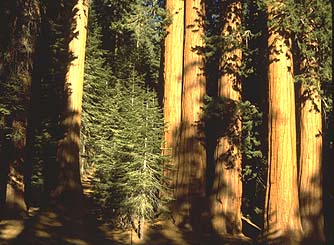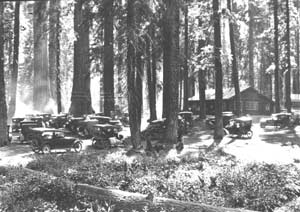Sierra Nature Notes, Volume 4, May 2004
Restoring
the Giant Sequoias at Giant Forest, Sequoia National Park
Athena Demetry
Restoration Ecologist
Sequoia and Kings Canyon National Parks
Patrick Whitmarsh
Comandra Technical Consulting
Part I: History and the Planning Process
 |
| Restoring a giant sequoia grove to its former pristine beauty is a project first envisioned in the 1930s, and is at last well on its way to success. |
Awe-inspiring giant sequoia trees are among the largest life forms on earth, but the opportunity to experience them is rare. Only about 75 groves exist, and only along the southern Sierra’s western slope on moist sites between about 5,000 and 7,000 feet in elevation. Giant Forest, one of the largest groves, was saved from logging by the establishment of Sequoia National Park in 1890. However, national park status did not fully protect these giants. The road that brought visitors to Giant Forest also brought camping, cabins, commercial development, and congestion. The impacts of this development, both to the giant sequoia ecosystem and to the quality of visitor experience, conflicted with the National Park Service mandate to conserve park resources and values and leave them unimpaired for the enjoyment of present and future generations. An early park superintendent, Colonel John Roberts White, recognized these problems over 70 years ago and vigorously toiled to leave them undisturbed by development. While largely unsuccessful in clearing structures from Giant Forest, he did prevent additional development and set the stage for the eventual restoration of Giant Forest.
Years of planning, design, and construction are now converging into the realization of Colonel White’s vision. All commercial activity has been removed from Giant Forest. Overnight accommodations have been relocated outside the grove to Wuksachi Village. Demolition of 282 buildings in Giant Forest is complete, and ecological restoration of 231 acres is well underway. The conversion of Giant Forest to a day use area is nearly complete.
The goal of the Giant Forest restoration project is to
restore the ecological health of the Giant Forest sequoia grove, home
of the world’s largest
trees, and further enhance the experience of visitors to these magnificant
groves.
Critical changes needed
Impacts from nearly 100 years of development threatened
the giant sequoia ecosystem that the National Park Service was charged
to protect for future generations. To construct
roads and parking lots, sequoia roots had been pruned, small portions of
wetland and riparian areas had been filled over, and drainage patterns
had been changed. Outdated utility systems leaked effluent into meadows
and streams. Trampling and automobile use had compacted, eroded, and degraded
soils, and pavement remained in abandoned campgrounds - all preventing
germination and establishment of grasses, wildflowers, shrubs, and tree
seedlings.
Fire, a critical factor for establishing the next generation of sequoias, was eliminated from the developed zone. Traffic congestion and limited opportunities for people with disabilities impaired visitor enjoyment. Aging, dilapidated structures were costly to maintain and service. Equally important, the very existence of buildings amongst this magnificent and ancient forest was jarring to the senses of visitors seeking the profound stillness a giant sequoia grove provides.
Continued development in Giant Forest would have greatly increased the overall negative effect on the health of the grove. Replacing underground water and sewer systems would have required cutting mature sequoia roots, which has been shown to decrease the growth rate of mature giant sequoias. Young giant sequoias, as well as many other trees, shrubs, and wildflowers, would fail to regenerate because of impacts to the soil and the absence of fire. Removal of hazardous trees would continue to alter forest structure. Future generations would see an unnatural forest radically different from what we see today.
The Early Years
 |
| In a scene typical
of the Giant Forest's early days, automobiles appear as numerous as
trees. © NPS photo |
Commercial recreation use of Giant Forest began in 1899 with the construction of a tent camp that was accessed via pack train. In 1903 a proper road was completed and the tent camp grew accordingly. The terminus of the road at Round Meadow became the location for a ramshackle assemblage of semi-permanent summer camps, along with administrative and concessioner buildings. Ensuing campaigns to draw people to the national parks in general, and to see the "big trees" in particular, produced an eightfold increase in visitation. For example, the first formal lodge was erected in the summer of 1915 in anticipation of visitation spilling over from the Panama-Pacific Exhibition in San Francisco. In 1921, the concessioner erected the cabins that formed the core of the lodging area next to Round Meadow, for which the name "Giant Forest Lodge" was first applied in 1926. In the same summer, "Camp Kaweah" (Upper Kaweah) was established with the goal of pulling overnight development away from Round Meadow. Pinewood was developed in 1931 with the same goal. All this led to an infrastructure that by 1930 amounted to four campgrounds, dozens of parking lots, a garbage incinerator, water and sewage systems, a gas station, corrals, and over 200 cabin, tent-top, dining, office, retail, and bath-house structures. Many of these were located directly among stands of monarch sequoias.
The outspoken Colonel White was to be Superintendent of the parks for two decades, beginning in the late-1920’s. During that time, his conviction regarding the restoration of the Giant Forest would grow in nearly equal measure to the power of the Sequoia and General Grant National Parks Company. The latter won out in almost every regard during Colonel White’s tenure as park superintendent. In 1931 Colonel White stepped up his battle against development in Giant Forest by refusing the concessioner’s proposed addition of five new cabins to the Giant Forest Lodge. He refused on the grounds that "the company should not be in the sequoia grove in the first place." The Director of the National Park Service overruled White’s decision. While Colonel White was not successful in gaining the Director’s support for removal of development from the grove, he did institute limits on guest capacity. This was the first NPS limit on tourism development in any of its parks. The concessioner was able to construct additional development before hitting this limit, and within a few years of Colonel White’s retirement, the grove was to contain more than 400 structures.
By the 1970s, the National Park Service recognised the serious consequences of development in Giant Forest and, by 1980, produced a Development Concept Plan (DCP). The plan redefined visitor use for the area. Giant Forest would become a day-use area only, with food service and overnight facilities relocated outside the grove. Access to Giant Forest’s best-known features would be limited to shuttle service or walking. No private automobiles would be allowed to park in the grove, and visitor parking would be consolidated into a single parking structure at the Wolverton corrals. Dispersed, non-vehicular exploration of Giant Forest would be encouraged in order to provide visitors with significant opportunities to interact with giant sequoias on foot rather than from vehicles.
Upon a more detailed examination of the cost of erecting a large (1,700 vehicle) parking structure at Wolverton, it became evident that a single large parking structure from which a free shuttle would provide access to key features in Giant Forest would be prohibitively expensive. In 1995, the Park Service invited public comment on an Interim Management Plan that explored other alternatives for day use of the grove. This plan was entitled "interim" because it recognized that the 1980 Development Concept Plan remains the park’s long-term goal, but alternatives to the parking structure and shuttle system were necessary to carry Giant Forest through the next 10 to 20 years. During this time, a review of the park’s long-term goals for all areas would be undertaken.
The final Interim Management Plan was issued in 1996 and called for focusing visitor experience in three areas:
The resulting Giant Forest restoration project - including the construction to replace facilities in the Wuksachi area, the removal of development from Giant Forest, ecological restoration, and development of new visitor facilities - has been the top construction funding priority in the National Park Service for over a decade.
Continue to Part 2: The Restoration
Our Founder Questions? Go to About Our New Site |
Masthead
Photo from: |